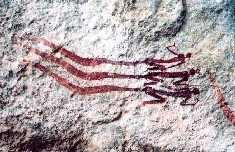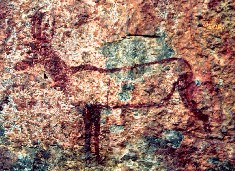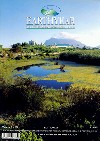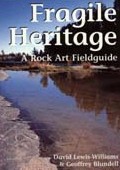'Vapour trails' of time rise
Barbara Ludman
31 December 2003
The images appear in a granite rock shelter in a small mountain range, the
Krokodilpoortsberg, east of Nelspruit. Along with roan antelope and
paintings of San women's aprons are figures that appear rarely, and only in Mpumalanga province: humans with long, curving tails, like streamers, nesting one
inside the other.
The "vapour trails" have put rock art in the province on the map, but there's
much more to see.
"I've lost count of how many, but there are more than 200 sites", says
Conraad de Rosner, a young game
ranger who manages Ingwe, a small camp near
Bongani Lodge in Mpumalanga. "Last week I found three new sites. An area
had been burnt and I went to look for injured game. There were three sets
of massive granite boulders, all with human figures.
"It's happened before. The record is six sites in one day."
He stands on the terrace of Bongani, where he began his career in the bush,
and gestures north, towards the range. "All those mountains you can
see are filled with rock art. People knew of one site here and one there.
But no one realised the extent of the shelters found in this area."
De Rosner spends every spare moment climbing in the Krokodilpoortsberg,
looking for rock paintings - generally on his own but sometimes with a colleague,
game ranger Gideon Twala, who is also captivated by these ancient images
and has discovered sites of his own. Both will take lodge guests to a selection of sites; Bongani, in fact, is known for its rock art tours.
Bongani and
Ingwe are sited in the Mthethomusha game reserve on land owned
by the adjacent Luphisi and Mpakeni communities, which have leased it to the
Mpumalanga Parks Board.
CCAfrica, or Conservation Corporation, contracted by a company called Inzalo to run the game reserve, makes a point of giving something back, working through the Africa Foundation, to the communities where it does business.
For Luphisi and Mpakeni, it's an ideal situation, one which has brought them
schools, electrification, training and bursaries. Trainee rangers and
hotel-keepers at Bongani are all drawn from the communities who own the
reserve. And there is more to be had from the reserve than tourism: the land in the reserve is accessible for those who wish to harvest medicinal plants, and
game meat is supplied to the tribal authority for distribution.
It's also ideal for De Rosner, who is encouraged - indeed, subsidised with
equipment and materials - by Inzalo and CCAfrica to spend his free time
finding and
recording rock art sites.
Not that he needs much encouragement. When stumbling on a site never before
recorded, he says, "something grabs you and twists you around. I'm
catapulted back into that ancient world."
The sites are very old. "There's no historical record of San in that
area", says Professor David Lewis-Williams, the doyen of San rock art, "so
we suspect that these are in fact very old, some thousands of
years - probably more than 2 000 years old."
De Rosner contacted the Rock Art Research Institute at the University of the
Witwatersrand three years ago, when Lewis-Williams, who has since retired, was
director, and sent members of the Institute's rapid response field team, Jamie Hampson and William Challis, out to mentor him. They came out every few months and stayed for about a fortnight, often bringing students and field assistants.
"William, Conraad and I went out into the field together, Conraad carrying
his pistol or rifle" – not
to ward off dangerous animals but for defence against poachers, says Hampson. "We occasionally encountered rhino, lion and
buffalo on the trail, but on the whole we had few problems, and the mambas
left us alone."
The Wits team only found three or four "new" sites, but that wasn't their
job; they were out there to record the paintings De Rosner had found. It
was a matter of two or three days per site, says Hampson, and fairly
arduous work.
They were also tasked with teaching De Rosner how to copy the paintings
without damaging them. "It's a difficult job," says Lewis-Williams. "It's
backbreaking work. Conraad does a lot of the tracing, which he does very
well; he's very careful. He has produced an astonishing amount of
material. We had no idea there was quite so much there. It was pretty much
a blank on the map of rock art."
Farmers in the area knew about the odd rock painting on their property, but
it wasn't until now-retired game ranger Mike English
began photographing
what he found in the Kruger Park that anyone realised just how much there might
be.
In the 1980s, English was stationed in the extreme southwest of the
reserve, just over the boundary from Bongani. "There was a lot of
poaching there”, he says. "Poachers used to come in sometimes for a week or more in the mountains where it was difficult to track them down. They used to stay in shelters."
English did a ground survey of the area looking for poachers' hiding
places and found, instead, rock paintings – more than 100.
He mapped the sites, took slides of about half the art he'd found, invited
Lewis-Williams and specialist Bert Woodhouse to take a look, and registered
his project with the National Parks Board, now SANParks.
Like those at Bongani, the rock paintings show signs of antiquity: there are no representations of domestic animals, no recent historical scenes - and there are vapour trails, "right from the south to the north. There is
such a terrific scope of rock paintings, I'd like to see someone get on with it."
Eventually he sold the project to Goldfields, which donated it to SANParks
- where, says cultural resources manager Johan Verhoef, the slides are being incorporated into a cultural resources database.
"We are at the moment looking at opening up rock art sites to the general public," says Verhoef, "hopefully this year."
There are problems to be solved first - the general inaccessibility of most of the sites, for example, and finding a way to protect the sites from harm and manage them properly. At the moment, visitors who want to see rock art in the Kruger Park sign up for the Bushman Walking Trail - essentially a game trail where viewing rock art can be included.
How old is the rock art in Mpumalanga? "We don't know," says Lewis-Williams. "There's no direct way of dating it. If the pigment was ochre, and it was, you can’t get a carbon date on it.”
The Institute has found blood, however,
in the mix of ochre and other materials used in the rock art palette in the Drakensberg, and there is a possibility that blood was used to bind the powders used in the Krokodilpoortsberg paintings as well. One can get a carbon dating from blood, so eventually the art can be dated.
But it’s not going to happen anytime soon. Permission must first be granted by both the landowners and the South African Heritage Resources Agency before any large-scale testing can go ahead. However, says Lewis-Williams, “once the technique has been refined in the southern Drakensberg, where the paintings are so much better preserved and more recent, then we will extend it to other parts of the country”.
By that time, the way things are going, De Rosner will no doubt have uncovered another 200 paintings in the granite rock shelters of the Krokodilpoortsberg.
This article was first published in Earthyear Magazine, The
Essential Environmental Guide. Volume I, 2003 is now available at CNAs and
selected bookstores countrywide. Or visit the Earthyear website.
 One of Mpumalanga's unique 'vapour trail' rock paintings (Photo: Conraad de Rosner)
One of Mpumalanga's unique 'vapour trail' rock paintings (Photo: Conraad de Rosner)
 Blood, ash, ochre - and a buck springs to life on a rock shelter in Mpumalanga (Photo: Conraad de Rosner)
Blood, ash, ochre - and a buck springs to life on a rock shelter in Mpumalanga (Photo: Conraad de Rosner)







